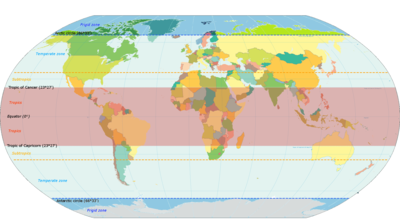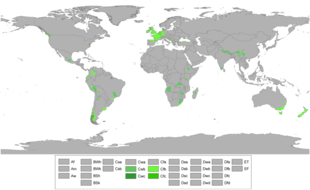Temperate climate


| Part ofa serieson |
| Weather |
|---|
|
|
Ingeography,thetemperate climatesofEarthoccur in themiddle latitudes(approximately 23.5° to 66.5° N/S of Equator), which span between thetropicsand thepolar regions of Earth.[1]These zones generally have widertemperatureranges throughout the year and more distinctseasonalchanges compared totropical climates,where such variations are often small; they usually differ only in the amount ofprecipitation.[2]
In temperate climates, not only dolatitudinal positionsinfluence temperature changes, but various sea currents, prevailing wind direction, continentality (how large a landmass is) and altitude also shape temperate climates.[3]
TheKöppen climate classificationdefines a climate as "temperate"C,when the mean temperature is above −3 °C (26.6 °F) but below 18 °C (64.4 °F) in the coldest month to account for the persistence of frost. However, some adaptations of Köppen set the minimum at 0 °C (32.0 °F).Continental climatesare classified asDand considered to be varieties of temperate climates, having more extreme temperatures, with mean temperatures in the coldest month usually being below −3 °C (26.6 °F).
Zones and climates
[edit]Thenorth temperate zoneextends from theTropic of Cancer(approximately 23.5° north latitude) to theArctic Circle(approximately 66.5° north latitude). Thesouth temperate zoneextends from theTropic of Capricorn(approximately 23.5° south latitude) to theAntarctic Circle(at approximately 66.5° south latitude).[4][5]
In some climate classifications, the temperate zone may be divided into several smaller climate zones, based on monthly temperatures, the coldest month, and rainfall. These can include the subtropical zone (humid subtropicalandMediterranean climate), and the cool temperate zone (oceanicandcontinental climates).[6]
Subtropical zone
[edit]These climates are typically found in the more equatorial regions of the temperate zone, between 23.5° and 35° north or south. They are influenced more by the tropics than by other temperate climate types, usually experiencing warmer temperatures throughout the year, with longer, hotter summers and shorter, milder winters. Freezing precipitation is uncommon in this part of the temperate zone.
Humid subtropical (Cfa) and monsoon subtropical (Cwa) climates
[edit]
Humid subtropical climatesgenerally have long, hot and humid summers with frequent convective showers in summer, and a peak seasonal rainfall in the hottest months. Winters are normally mild and above freezing in the humid subtropics. Warm ocean currents are usually found in coastal areas with humid subtropical climates.[7]This type of climate is normally located along leeward lower east coasts of continents such as in southeast and centralArgentina,Uruguayand south ofBrazil,the southeast portions ofEast Asia,southernand portions of the northeast and midwesternUnited Statesand portions of,South Africa,Ethiopia,and easternAustralia.In some areas with a humid subtropical climate (most notably southeastChinaandNorth India), there is an even sharper wet-dry season, called a monsoon subtropical climate or subtropical monsoon (Cwa). In these regions, winters are quite chilly and dry and summers have very heavy rainfall. Some Cwa areas in southern China report more than 80% of annual precipitation in the five warmest months (southwest monsoon).
Mediterranean climates (Csa, Csb)
[edit]
Mediterranean climateshave the opposite rainfall pattern to dry-winter climates, with a dry summer and wet winter. This climate occurs mostly at the western edges and coasts of the continents and are bounded by arid deserts on their equatorward sides that brings dry winds causing the dry season of summer, and oceanic climates to the poleward sides that are influenced by cool ocean currents and air masses that bring the rainfall of winter. The five main Mediterranean regions of the world are theMediterranean BasininNorth Africa,Southern Europe,andWest Asia,coastalCaliforniain theUnited States,theSouthandWeststates ofAustralia,theWestern CapeofSouth Africaand the south and southwestern coast ofChile.[8]
Subtropical highland climates (Cwb, Cfb)
[edit]
Subtropical highland climatesare climate variants often grouped together with oceanic climates found in some mountainous areas of either the tropics or subtropics. They have characteristically mild temperatures year-round, featuring the four seasons in the subtropics and no marked seasons in the tropics, the latter usually remaining mild to cool through most of the year. Subtropical highland climates under the Cfb classification usually have rainfall spread relatively evenly in all months of the year similar to most oceanic climates[9]while climates under the Cwb classification have significant monsoon influence, usually having dry winters and wet summers.[10]
Middle latitude zone
[edit]These climates occur in the middle latitudes, between approximately 35° and 66.5° north and south of the equator. There is an equal climatic influence from both the polar and tropical zones in this climate region. Two types of climates are in this zone, a milder oceanic one and more severe seasonal continental one. Most prototypical temperate climates have a distinct four-season pattern, especially in the continental climate sector.
Oceanic climates (Cfb)
[edit]Oceanic climatesare created by the on-shore flow from the cool high latitude oceans to their west. This causes the climate to have mild summers and cool (but not cold) winters, and relative humidity and precipitation evenly distributed throughout the year. These climates are frequently cloudy and cool, and winters are milder than those in the continental climate.
Regions with oceanic climates includenorthwestern Europe,northwestern North America,southeastern and southwesternSouth America,southeasternAustraliaand most ofNew Zealand.[11]
Humid continental climates (Dfa, Dfb, Dwa, Dwb, Dsa, Dsb)
[edit]Humid continental climatesare considered as a variety of temperate climates due to lying in the temperate zones,[12]although they are classified separately from other temperate climates in theKöppen climate classification.In contrast to oceanic climates, they are created by large land masses and seasonal changes in wind direction. This causes humid continental climates to have severe temperatures for the season compared to other temperate climates, meaning a hot summer and cold winter. Precipitation may be evenly distributed throughout the year, while in some locations there is a summer accent on rainfall.
Regions with humid continental climates include southeastern Canada, the upper portions of the easternUnited States,portions of easternEurope,parts ofChina,Japanand theKorean Peninsula.
Subpolar zone
[edit]These are temperate climates that compared to the subtropics are on the poleward edge of the temperate zone. Therefore, they still have four marked seasons including a warmer one, but are far more influenced by the polar zones than any other but the very polar climates (tundraandice cap climate).
Subpolar oceanic and cold subtropical highland climates (Cfc, Cwc)
[edit]Areas with subpolar oceanic climates feature an oceanic climate but are usually located closer to polar regions. As a result of their location, these regions tend to be on the cool end of oceanic climates. Snowfall tends to be more common here than in other oceanic climates. Subpolar oceanic climates are less prone to temperature extremes thansubarctic climatesorcontinental climates,featuring milder winters than these climates but still with similar summers.[citation needed]This variant of an oceanic climate is found in parts of coastalIceland,theFaroe Islands,parts ofScotland,northwestern coastal areas ofNorwaysuch asLofotenand reaching to 70° north on some islands, uplands near the coast of southwestern Norway, theAleutian IslandsofAlaskaand northern parts of theAlaskan Panhandle,some parts of SouthernArgentinaand Chile (though most regions are still classified as continental subantarctic), and a few highland areas ofTasmania,theAustralian AlpsandSouthern AlpsofNew Zealand.[citation needed]This type of climate is even found in tropical areas such as the Papuan Highlands in Indonesia. Cfc is the categorization for this regime. Even in the middle of summer, temperatures exceeding 20°C (68 °F) are exceptional weather events in the most maritime of those locations impacted by this regime.[citation needed]In some parts of this climate, temperatures as high as 30°C (86°F) have been recorded on rare occasions, while temperatures as low as −15 °C (5 °F) have still been recorded on rare occasions.[citation needed]
A cold variant of the monsoon-influenced subtropical highland climate similar to subpolar oceanic climates occurs in small areas in Yunnan,Sichuanand parts of theAltiplanobetweenBolivia,PeruandChile,where summers are sufficiently short to beCwcwith fewer than four months over 10 °C (50 °F) due to the high altitudes at these locations.[13]El Alto, Bolivia,is one of the few confirmed towns that features this variation of the subtropical highland climate.
Cold summer mediterranean climates (Csc)
[edit]Cold summer mediterranean climates (Csc) are present in high-elevation areas around coastalCsbclimate areas, where the strong maritime influence prevents the average winter monthly temperature from dropping below 0 °C. Despite the maritime influence, they are classified alongside other mediterranean climates in the Köppen classification rather than oceanic climates like subtropical highland climates due to the opposite rainfall pattern. This climate is rare and is predominantly found in climate fringes and isolated areas of theCascadesandAndes Mountains,as the dry-summer climate extends further poleward in the Americas than elsewhere.[14]
Human aspects
[edit]Demography, fauna and flora
[edit]The vast majority of the world's human population resides in temperate zones, especially in theNorthern Hemisphere,due to its greater mass of land and lack of extreme temperatures.[15]The biggest described number of taxa in a temperate region is found insouthern Africa,where some 24,000 taxa (species and infraspecific taxa) have been described.[16]
Agriculture
[edit]Farming is a large-scale practice in the temperate regions (except for boreal/subarctic regions) due to the plentiful rainfall and warm summers, because most agricultural activity occurs in the spring and summer, cold winters have a small effect on agricultural production. Extreme winters or summers have a huge impact on the productivity of agriculture which is less common.[17]
Urbanization
[edit]Temperate regions have the majority of the world's population, which leads tolarge cities.There are a couple of factors why the climate of large city landscapes differs from the climate of rural areas. One factor is the strength of the absorption rate of buildings and asphalt, which is higher than that of natural land. The other large factor is the burning of fossil fuels from buildings and vehicles. These factors have led to the average climate of cities to bewarmer than surrounding areas.[17]
See also
[edit]- Geographical zone
- Habitat
- Köppen climate classification
- Middle latitudes
- Polar circle
- Subtropics
- Tropics
- Subarctic
- Highland temperate climate
- Humid temperate climate
- Subhumid temperate climate
References
[edit]- ^"Weather & Climate Change: Climates around the world".Education Scotland.Archived fromthe originalon 14 April 2016.
- ^Society, National Geographic (21 January 2011)."tropics".National Geographic Society.Retrieved27 March2022.
- ^"What Are the Forty Factors That Influence OurWeather?".Education – Seattle PI.19 December 2013.Retrieved27 March2022.
- ^McColltoll, R. W. (2005).Encyclopedia of World Geography, Volume 1.Facts on File Library of World Geography. New York: Facts on File. p. 919.ISBN0-816-05786-9.
- ^"Solar Illumination: Seasonal and Diurnal Patterns".Encyclopedia.com.Retrieved4 October2012.
- ^"what are the four temperate climates? - Lisbdnet.com".Retrieved27 March2022.
- ^"humid subtropical climate | climatology".Britannica.Retrieved27 March2022.
- ^"Climate Types for Kids | Mediterranean Climate".www.climatetypesforkids.com.Retrieved27 March2022.
- ^Khan, Ansar; Niyogi, Dev; Fiorito, Francesco; Akbari, Hashem; Mithun, Sk (15 June 2022).Global Urban Heat Island Mitigation.Elsevier Science. p. 253.ISBN9780323897945.Retrieved1 July2023.
- ^"Mindat.org".www.mindat.org.Retrieved27 March2022.
- ^"What Are The Characteristics Of An Oceanic Type Of Climate?".WorldAtlas.5 February 2018.Retrieved27 March2022.
- ^Senker, Cath (3 May 2018).Temperate Climates.Raintree Publishers. p. 5.ISBN9781474738408.Retrieved23 June2023.
- ^Peel, M. C.; Finlayson, B. L.; McMahon, T. A. (11 October 2007)."Updated world map of the Köppen-Geiger climate classification"(PDF).Hydrology and Earth System Sciences.11(5): 1633–1644.Bibcode:2007HESS...11.1633P.doi:10.5194/hess-11-1633-2007.S2CID9654551.Retrieved5 December2022.
- ^McKnight, Tom L; Hess, Darrel (2000)."Climate Zones and Types".Physical Geography: A Landscape Appreciation.Upper Saddle River, NJ: Prentice Hall.ISBN978-0-13-020263-5.
- ^Cohen, Joel E.; Small, Christopher (24 November 1998)."Hypsographic demography: The distribution of human population by altitude".Proceedings of the National Academy of Sciences of the United States of America.95(24): 14009–14014.Bibcode:1998PNAS...9514009C.doi:10.1073/pnas.95.24.14009.PMC24316.PMID9826643.
- ^Germishuizen, Gerrit; Meyer, N. L., eds. (January 2003).Plants of Southern Africa: An Annotated Checklist(PDF).Strelitzia. Vol. 14. Pretoria: National Botanical Institute.ISBN978-1-919795-99-7.
- ^abBurroughs, William James (1999).The Climate Revealed.New York: Cambridge University Press. p. 114.ISBN978-0-521-77081-1.
